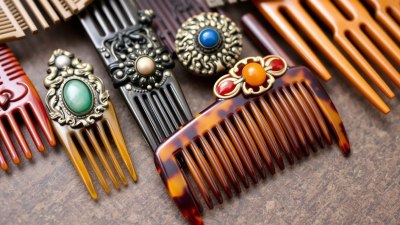Building a Collection of Local Vintage Combs from Markets
Discover how to create a stunning collection of local vintage combs from flea markets and antique shops.

Image created with Flux Schnell
Collecting local vintage combs can be a uniquely rewarding hobby. Vintage combs not only represent the stylistic trends of their time but also tell the stories of the people who used them. Whether you’re an avid collector or just starting out, exploring flea markets, antique shops, and local markets can yield some incredible finds. Each comb can provide a glimpse into the past, showcasing materials, craftsmanship, and aesthetics that modern combs may lack. In this guide, we’ll explore different types of vintage combs, tips on how to build your collection, and where to find them.
Understanding Vintage Combs
Before diving into the world of vintage combs, it’s essential to understand what makes them unique. Vintage combs can be made from a variety of materials including celluloid, tortoiseshell, bakelite, metal, wood, and plastic. Each material brings a different appeal and signifies various manufacturing eras. Combs made from tortoiseshell, for example, were highly prized in the late 19th and early 20th centuries due to their elegant appearance and durability. On the other hand, bakelite combs became popular in the early 20th century and are known for their bold colors and Art Deco designs. Understanding these materials will help you appreciate the history and value of each piece.
Types of Vintage Combs
When building your collection, familiarize yourself with the various types of vintage combs. Here are some categories you might consider:
1. Hair Combs: These are the most common type and serve practical purposes. They can range from simple, utilitarian designs to ornate, decorative pieces.
2. Pocket Combs: Compact and portable, pocket combs are designed to fit in small spaces and were often carried by men in wallets or jacket pockets.
3. Dress Combs: Usually larger and more ornate, dress combs are primarily for decorative purposes and were often used during formal occasions.
4. Theme Comb Sets: Some combs were created as part of a themed set, which might include matching brushes and accessories.
Where to Search for Vintage Combs
Finding vintage combs can be an adventure. Here are several great places to search:
1. Flea Markets: These are treasure troves for vintage items. You’ll likely find a mix of dealers, some specializing in hair accessories.
2. Antique Shops: Check out local antique stores, as they often carry vintage combs and other hair accessories.
3. Estate Sales: Attending estate sales can lead you to unique combs that may not be available anywhere else.
4. Online Marketplaces: Websites like eBay, Etsy, and specialized vintage marketplaces can be a valuable resource for finding rare combs.
Tips for Building Your Collection
As you embark on your journey to collect vintage combs, here are some practical tips to keep in mind:
1. Set a Budget: Vintage combs can range from very affordable to quite pricey. Determine how much you’re willing to spend before shopping.
2. Focus on Quality: Look for combs in good condition. Avoid plastic items with significant wear, chips, or cracks, as these might not hold their value.
3. Research Makers and Brands: Familiarize yourself with reputable makers, such as Gero, which produced high-quality celluloid combs, or William Scholl, known for wooden combs.
4. Start with a Theme: Consider starting your collection based on a theme, such as a particular era, material, or design style. This focus can make the hunting process more enjoyable.
5. Document Your Collection: Keep a record of each comb, noting its history, origin, and features. Take photographs to create an inventory and track your progress.
Care and Maintenance
Once you’ve started to build your collection, it’s crucial to maintain your combs. Here are a few tips on cleaning and storage:
1. Clean Gently: Most vintage combs can be cleaned with mild soap and water. Avoid harsh chemicals that could damage the material.
2. Avoid Direct Sunlight: Ultraviolet rays can cause colors to fade, particularly in older plastics. Store your combs in a cool, dry place away from sunlight.
3. Use Soft Storage: Consider placing combs in soft pouches or on soft fabric to prevent scratches during storage.
Connecting with Other Collectors
Joining a community of vintage comb collectors can enhance your experience. Look for local clubs, online forums, or social media groups where you can share finds, ask questions, and get advice. Participating in discussions can also expose you to new resources or selling opportunities.
Building a collection of local vintage combs is not just about amassing items; it’s about connecting with history and culture. Each comb you collect adds depth to your understanding of fashion and personal grooming trends throughout the years. Embrace the adventure of hunting for unique pieces, and enjoy the process of curating your collection. Happy collecting!











